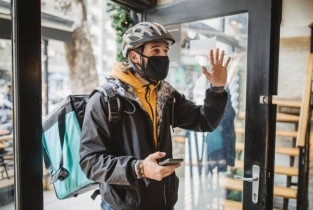Food Safety for Home Deliveries with Considerations for COVID-19 (Industry Edition)
ID
FST-393NP
Introduction
Coronavirus 19 disease (COVID-19) transmission is spread from human-to-human contact. There is currently no evidence to suggest that food or food packaging can transmit COVID-19. Home deliveries are considered low risk for transmission; however, basic food safety principles that reduce the risk of foodborne illness can also reduce the risk of COVID-19 transmission even further, when applied.
Personal Health
- Wash hands with soap and water for at least 20 seconds when hands become visibly dirty, after using the restroom, eating, or touching high contact surfaces.
- If soap and water are not available, use hand sanitizer with at least 60% alcohol (see: https://www.fda.gov/drugs/information-drug- class/qa-consumers-hand-sanitizers-and-covid-19).
- If you’re showing signs of illness including vomiting, diarrhea, jaundice, sore throat, and fever, stay home.
- Have tissues readily available so if you cough or sneeze, you can reduce the likelihood of getting germs on your hands.
Best Practices for Home Delivery Drivers
- Have thermal bags on hand for transporting hot and cold foods. If possible, use ice or gel packs for cold food (make sure separation between ice and food), and insulated bags for hot foods (Figure 1).
- Perishable food can grow bacteria in as quickly as 20 minutes, if held within the danger zone, temperatures between 40°F and 140°F (see: https://www.fsis.usda.gov/food-safety/safe-food-handling-and-preparation/food-safety- basics/danger-zone-40f-140f)
- Avoid opening any food containers to check contents. Instead, ask the restaurant preparing the food to confirm the accuracy of an order, if needed.
- Ensure the packaging is secure before taking an order out for delivery. Tampering with foods or insufficient packaging can introduce pathogens that may make the customer sick.

COVID-19 Considerations
Social Distancing
- Person to person transmission of COVID-19 is the biggest risk to infection. If possible, opt for contact-less pick-up and delivery to the final customer (Figure 2).
- People can be ill without presenting any symptoms, so if contact-less pick-up or delivery is not available, keep at least 6 feet between person to person.

Wear Masks
- Wearing masks reduces the risk for transmission of COVID-19. If you have to get within 6 feet of a person, you and that individual should both wear masks.
- The Centers for Disease Control and Prevention recommends a mask or facial covering that has at least two layers, covering your nose and mouth, and secured under your chin.
- Masks protect your nose and mouth from saliva particles that can transmit COVID-19 during person-to-person contact/especially during conversation (e.g., food transactions).
Cleaning and Sanitizing/Disinfecting
- Always remember to clean surfaces, before sanitizing or disinfecting, as you cannot sanitize or disinfect a dirty surface. You want to sanitize or disinfect harmful germs, not organic matter, such as food debris.
- Sanitize/disinfect all high contact surfaces, such as your car door handles, car steering wheel, cell phone, writing utensils, GPS unit, frequently between uses, before and after working times.
- Use an EPA Registered Antimicrobial Product (see https://www.epa.gov/coronavirus/about-list-n-disinfectants-coronavirus-covid-19-0).
References
- US Centers for Disease Control and Prevention (CDC). 2021. Q&A for Consumers: Hand Sanitizers and COVID-19. Available at: https://www.fda.gov/drugs/information-drug- class/qa-consumers-hand-sanitizers-and-covid-19.
- US Department of Agriculture Food Safety and Inspection Service (FSIS). 2021. Danger Zone. Available at: https://www.fsis.usda.gov/food-safety/safe-food-handling-and-preparation/food-safety-basics/danger-zone-40f-140f.
- US Environmental Protection Agency (EPA). 2021. Disinfectants for Coronavirus (COVID- 19). Available at: https://www.epa.gov/coronavirus/about-list-n-disinfectants-coronavirus-covid-19-0.
Acknowledgments
This work was adapted from Chylsea Alexander’s Online Master’s Degree in Agricultural and Life Sciences (OMALS) project and report at Virginia Tech (2020).
Virginia Cooperative Extension materials are available for public use, reprint, or citation without further permission, provided the use includes credit to the author and to Virginia Cooperative Extension, Virginia Tech, and Virginia State University.
Virginia Cooperative Extension is a partnership of Virginia Tech, Virginia State University, the U.S. Department of Agriculture (USDA), and local governments, and is an equal opportunity employer. For the full non-discrimination statement, please visit ext.vt.edu/accessibility.
Publication Date
September 16, 2021



